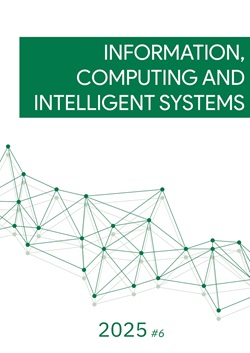Statistical Evaluation of Parameters in Nonlinear Models Using Integral-Form of Least Squares Method and Differential Non-Taylor Transformations
DOI:
https://doi.org/10.20535/2786-8729.6.2025.332702Keywords:
data science, statistical learning, time series, nonlinear models, differential transformations, least squares methodAbstract
The article presents the method for statistical leaning of nonlinear model parameters, its principle and efficiency of application. It proposes a solution to the shortcomings of using the differential spectra balance approach through the integral form of least squares in the scheme of differential non-Taylor transformations.
The object of the study is the process of statistical learning of nonlinear model parameters. The purpose of this paper is to formulate the statistical learning method for evaluation of nonlinear model parameters using LSM in integral form and differential non-Taylor transformations. It is relevant in many areas of modern activity and is necessary for applying the statistical training methodology to a more complex time series, as well as increasing the accuracy of the received expectations.
To achieve this goal the statistical learning methodology was proposed, which is based on the creation of process model in integral form of least squares with simplification using non-Taylor transformations. It differs from existing approaches by incorporating all the available differential discretes in the created model, which allows for better predictability and circumvents the problem of unequal count of discretes inside the models, which allows for better application of the method for different model forms. The algorithm for the process was formed, using which it can be applied different models. In the paper several experiments were conducted to verify the efficacy of the proposed method in different situations. These experiments use generated datasets that are polluted with stochastic errors to better simulate real data.
The results of modeling are shown, and the statistical characteristics of the obtained expectation are compared with the results of the application of the statistical training methodology using the differential spectra balance. During the study, features of the technique were found that must be considered for its application to data with a high number of stochastic deviations. Based on the obtained metrics, a conclusion is made about the effectiveness of using the technique relative to time series reflecting processes of different nature.
References
G. James, D. Witten, T. Hastie, R. Tibshirani, and J. Taylor, An Introduction to Statistical Learning. Springer, 2023, https://doi.org/10.1007/978-3-031-38747-0.
M. Nguyen, A Guide on Data Analysis. Bookdown, 2020. [Online] Available: https://bookdown.org/mike/data_analysis/
S. C. Chapra and R. P. Canale, Numerical Methods for Engineers, 7th ed. New York, NY, USA: McGraw-Hill Education, 2015.
T. Hastie, R. Tibshirani, and J. Friedman, The Elements of Statistical Learning. New York, NY: Springer New York, 2009, https://doi.org/10.1007/978-0-387-84858-7.
F. Provost and T. Fawcett, Data Science for Business: What You Need to Know About Data Mining and Data-Analytic Thinking. Beijing, China: O’Reilly Media, 2013.
Oleksandr Tuhanskykр, D. Baran, and Oleksii Pysarchuk, “Method for Statistical Evaluation of Nonlinear Model Parameters in Statistical Learning Algorithms,” Lecture notes in networks and systems, pp. 265–274, Jan. 2024, https://doi.org/10.1007/978-981-97-3559-4_21.
O. O. Pysarchuk, O. A. Tuhanskykh, and D. R. Baran, “Method for determining the structure of nonlinear models for time series processing” Radio Electronics Computer Science Control, no. 1, pp. 53–62, Apr. 2025, https://doi.org/10.15588/1607-3274-2025-1-5.
D. Dietrich, B. Heller, and B. Yang, Data Science & Big Data Analytics: Discovering, Analyzing, Visualizing and Presenting Data. Indianapolis, IN, USA: Wiley, 2021.
S. Konishi, Introduction to Multivariate Analysis. Informa, 2014, https://doi.org/10.1201/b17077.
E. W. Grafarend, S. Zwanzig, and J. L. Awange, Applications of Linear and Nonlinear Models. Cham: Springer International Publishing, 2022, https://doi.org/10.1007/978-3-030-94598-5
A. W. Roddam, “Measurement Error in Nonlinear Models: A Modern Perspective,” Journal of the Royal Statistical Society Series A (Statistics in Society), vol. 171, no. 2, pp. 505–506, Mar. 2008, https://doi.org/10.1111/j.1467-985x.2007.00528_4.x.
V. P. Kharchenko, О. О. Pysarchuk Nelinijne ta bagatokryterialne modelyuvannya procesiv u systemax keruvannya ruxom, Kyiv, Ukraine: Instytut obdarovanoyi dytyny, 2015.
G. E. Puhov, Dyferentsiini spektry ta modeli. Kyiv, Ukraine: Naukova Dumka, 1990.
G. E. Puhov, Dyferentsiini peretvorennia ta matematychne modeliuvannia fizychnykh protsesiv. Kyiv, Ukraine: Naukova Dumka, 1986.
R. H. Shumway and D. S. Stoffer, Time Series Analysis and Its Applications. New York, NY: Springer New York, 2011, https://doi.org/10.1007/978-1-4419-7865-3.
M. K. Transtrum and J. P. Sethna, “Improvements to the Levenberg-Marquardt algorithm for nonlinear least-squares minimization,” arXiv (Cornell University), Jan. 2012, https://doi.org/10.48550/arxiv.1201.5885.
H. Wu, T. Hu, Y. Liu, H. Zhou, J. Wang, and M. Long, “TimesNet: Temporal 2D-Variation Modeling for General Time Series Analysis,” Oct. 2022, https://doi.org/10.48550/arxiv.2210.02186.
M. Jin et al., “Time-LLM: Time Series Forecasting by Reprogramming Large Language Models,” arXiv (Cornell University), Oct. 2023, https://doi.org/10.48550/arxiv.2310.01728.
Downloads
Published
How to Cite
Issue
Section
License
Copyright (c) 2025 Information, Computing and Intelligent systems

This work is licensed under a Creative Commons Attribution 4.0 International License.




